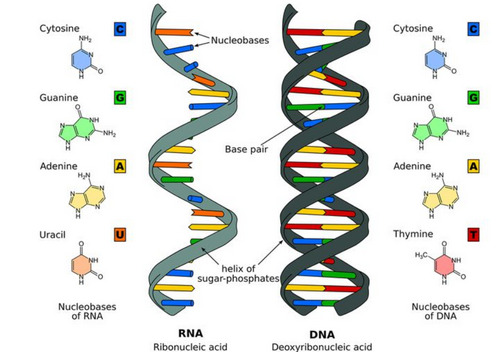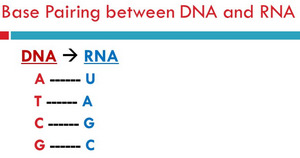Difference between DNA and RNA
Last reviewed by Editorial Team on February 27th, 2019.
There are two kinds of nucleic acids; the DNA and RNA. DNA (deoxyribonucleic acid) and RNA (ribonucleic acid) are two essential molecules as they are responsible for the heredity and evolution of an organism.
They store and read genetic information of life. Both DNA and RNA are linear polymers. They have sugar, bases, and phosphates.
Although the two share similar characteristics and functions, they do have some differences too. (1, 2)

Image 1: The structural differences between DNA and RNA
Picture Source: www.thoughtco.com

Picture 2: The DNA and RNA molecules.
Photo Source: cyberbridge.mcb.harvard.edu
Below are the key difference between DNA and RNA.
#1 – They differ in functions.
DNA
- It encodes genetic information.
- It is the blueprint in which all forms of life is created.
- It is a storage facility/biological flash drive enabling the genetic characteristics to be passed on from one generation to another. (1, 2, 3)
RNA
It reads the genetic information. The reading process is a complex one and there is a specific RNA responsible for every step. They are the following:
- Messenger RNA – It duplicates a part of the genetic code. Through the process of transcription and transport, the genetic code is transferred to ribosomes (the factory of the cell) which will be used to produce proteins from the specified genetic code.
- Transfer RNA – Using the coded instructions from the previous step, the transfer RNA will bring amino acid to the protein factories.
- Ribosomal RNA – It is a part of the ribosome factory and without it, protein production will not take place. (3, 4, 5)
#2 – They differ in sugar component
DNA
The sugar component of DNA is called deoxyribose, which means that it only has one hydroxyl group attached to its carbon backbone. This particular sugar makes the DNA more stable.
RNA
The sugar component of RNA is called ribose. The extra hydroxyl group of RNA is useful in converting genetic code into messenger RNA to be made into protein. (4, 5)

Photo 3: The base pairing of DNA and RNA.
Image Source: slideplayer.com
#3 – They differ in bases.
DNA
The order and pairing of nitrogen bases are important in biological functions. The four bases in DNA are:
- Adenine
- Thymine
- Guanine
- cytosine
RNA
It does not have thymine but it does have uracil bases. (2, 5)
#4 – They differ in structure
DNA
DNA is a double helix (two-stranded structure of DNA). It has longer polymers than the RNA. (6)
RNA
It can form into double-stranded structures depending on the functions it performs. (7)

Image 4: The location of DNA and RNA in the cells.
Picture Source: images.slideplayer.com
#5 – They differ in locations
DNA
Animal and plant cells (eukaryotic cells) have DNA in their nucleus and in some instances, in the mitochondria.
RNA
There are three types of RNA and they can be found in various locations.
- Messenger RNA – found in the nucleus and some of its fragments can be found in the cytoplasm.
- Transport RNA – It moves around the cytoplasm (free-roaming).
- Ribosomal RNA – It is a part of the ribosome. (5, 7, 8)

Picture 5: A cartographic presentation of DNA and RNA and their differences.
Photo Source: i.pinimg.com
The table below shows the brief difference between DNA and RNA.
| Area of comparison DNA |
(Deoxyribonucleic Acid) | RNA (Ribonucleic Acid) |
| Types | DNA has two basic types: Intra nuclear Extra nuclear |
RNA has three types: Messenger RNA Transfer RNA Ribosomal RNA |
| Functions | It encodes genetic information. It is the blueprint in which all forms of life is created. It is a storage facility/biological flash drive enabling the genetic characteristics to be passed on from one generation to another. |
It converts or interprets genetic information in the DNA which will be used for various cellular functions such as building proteins. |
| Structure | Two-stranded helix which consists of nucleotides. As with the length, DNA has longer polymer than the RNA. | It has one-strand consists of nucleotides. The strands of RNA are shorter when compared to DNA. The length varies but generally shorter than the DNA. |
| Helix geometry | β-form | α-form |
| Nucleotide chain | Long chain | Short chain |
| Number of molecules | The number of DNA is the same for every cell. | The number of RNA may vary from one cell to another. |
| Molecular weight | 2 – 6 million | 25, 000 – 2 million |
| Location | It can be found in the nucleus and some can be found in the mitochondria. | It is found in the nucleolus but eventually moves to some parts of the cytoplasm. |
| Sugar component | Deoxyribose (one less hydroxyl group than RNA) | Ribose sugar molecules |
| Bases and base pairs | The bases are:
Adenine The pairings are: Adenine and thymine pair |
The bases are:
Adenine The pairings are: Adenine and uracil |
| Reactivity | It is a more stable molecule compared to RNA. | It is more reactive than DNA. It is not stable in an alkaline environment. It is more likely to be attacked by enzymes because of its huge helical grooves. |
| Sensitivity to light | It is easily damaged when exposed to ultraviolet light. | It is resistant to ultraviolet light. |
| Ability to replicate | It replicates to form a new DNA molecule. | It does not have the ability to replicate itself. |
The DNA and RNA are the two primary nucleic acids. They are genetic materials present in every living cell. They are the same in composition but greatly differs in functions and structures.
DNA is the blueprint that contains the code for genetic material whereas the RNA is the one that reads the genetic code. It plays an important role in the production of protein.
DNA is a permanent molecule while the RNA is a transient one. DNA is a stable molecule whereas the RNA is not because the messenger RNA is degraded by the ribosomal RNA.
The double-stranded nature of the DNA makes it even more stable than the RNA. As with the complementary base pairs, both DNA and RNA share the same pairing with the exception of uracil.
RNA does not have thymine instead it is taken over by uracil. The two also differs in the sugar component. DNA has deoxyribose while RNA use ribose. (2, 8, 9, 10)
References:
- https://www.sparknotes.com/biology/molecular/structureofnucleicacids/section3/
- https://www.technologynetworks.com/genomics/lists/what-are-the-key-differences-between-dna-and-rna-296719
- https://www.thoughtco.com/dna-versus-rna-608191
- https://microbiologyinfo.com/differences-between-dna-and-rna/
- https://www.diffen.com/difference/DNA_vs_RNA
- https://biologywise.com/difference-between-dna-rna
- http://www.biologydiscussion.com/dna/difference-dna/difference-between-dna-and-rna/12169
- http://www.differencebetween.net/science/difference-between-dna-and-rna/
- https://www.biologyexams4u.com/2012/10/differences-between-dna-and-rna.html#.W_G_yPkzbZY
- https://www.albert.io/blog/similarities-between-dna-and-rna/
Similar Posts:
- Methyl Red Test
- Difference between Endotoxin and Exotoxin
- Types of Blood Cells
- Benedict’s Test
- Glycolysis Pathway – Definition and Summary
